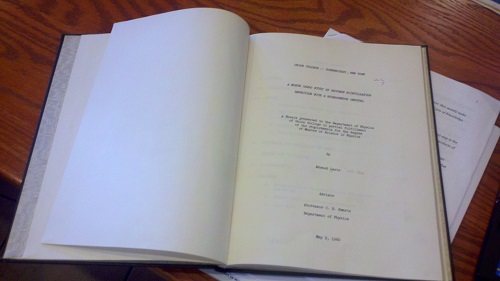The Twitter conversation that prompted yesterday’s post about composite objects was apparently prompted by a comment somebody made about how a virus left alone would see its quantum wavefunction spread out on a time scale of minutes. This led to wondering about whether a virus could really be considered a particle that would move as… Continue reading Quantum Viruses?
Category: Theory
When Is a Composite Object a Particle?
Through some kind of weird synchronicity, the title question came up twice yesterday, once in a comment to my TED@NYC talk post, and the second time on Twitter, in a conversation with a person whose account is protected, thus rendering it un-link-able. Trust me. The question is one of those things that you don’t necessarily… Continue reading When Is a Composite Object a Particle?
(Not-so-)Ancient History of Physics: Monte Carlo Simulation in 1960
We cleared a bunch of space in our deep storage area over the summer, and one of the things we found was a box full of old student theses from the 1950’s and 1960’s. The library already had copies of them, but I thought it was sort of cool to have a look into the… Continue reading (Not-so-)Ancient History of Physics: Monte Carlo Simulation in 1960
Things I’ve Never Quite Understood: Microscopic Picture of Blackbody Radiation
I’m putting together slides for a TED audition talk in a couple of weeks, about how the history of quantum mechanics is like a crossword puzzle. This involves talking about black-body radiation, which is the problem that kicked off QM– to explain the spectrum of light emitted by hot objects, Max Planck had to resort… Continue reading Things I’ve Never Quite Understood: Microscopic Picture of Blackbody Radiation
Trapping Neutrinos?
One of the chapters of the book-in-progress talks about neutrino detection, drawing heavily on a forthcoming book I was sent for blurb/review purposes (about which more later). One of the little quirks of the book is that the author regularly referred to physicists trying to “trap” neutrinos. It took me a while to realize that… Continue reading Trapping Neutrinos?
Fun With Simulated Scattering
Two chapters of the book-in-progress will be devoted to the development of the modern understanding of the atom. One of these is about the Bohr model, which turned 100 this year, but Bohr’s model would not have been possible without an earlier experiment. The actual experiment was done by Ernest Marsden and Hans Geiger, but… Continue reading Fun With Simulated Scattering
Spooky Action at What Distance?
When I wrote up the giant interferometer experiment at Stanford, I noted that they’ve managed to create a situation where the wavefunction of the atoms passing through their interferometer contains two peaks separated by almost a centimeter and a half. This isn’t two clouds of atoms each definitely in a particular position, mind, this is… Continue reading Spooky Action at What Distance?
Eddington, Neutrinos, and the Changing of Meaning by Context
I’m writing a bit for the book-in-progress about neutrinos– prompted by a forthcoming book by Ray Jaywardhana that I was sent for review– and in looking for material, I ran across a great quote from Arthur Stanley Eddington, the British astronomer and science popularizer best known for his eclipse observations that confirmed the bending of… Continue reading Eddington, Neutrinos, and the Changing of Meaning by Context
Driving a Simulated Pendulum
Some time back, I spent a bunch of time writing a VPython program that simulated the motion of a pendulum, which turned out to do some strange things. In the comments to that, there were two things worth mentioning: first and foremost, Arnoques at #5 spotted a small error in the code that fixes the… Continue reading Driving a Simulated Pendulum
Naming Names in QED
I’m doing edits on the QED chapter of the book-in-progress today, and I’m struck again by the apparent randomness of the way credit gets attached to things. QED is a rich source of examples of this, but two in particular stand out, one experimental and the other theoretical. On the experimental side, it’s interesting to… Continue reading Naming Names in QED







